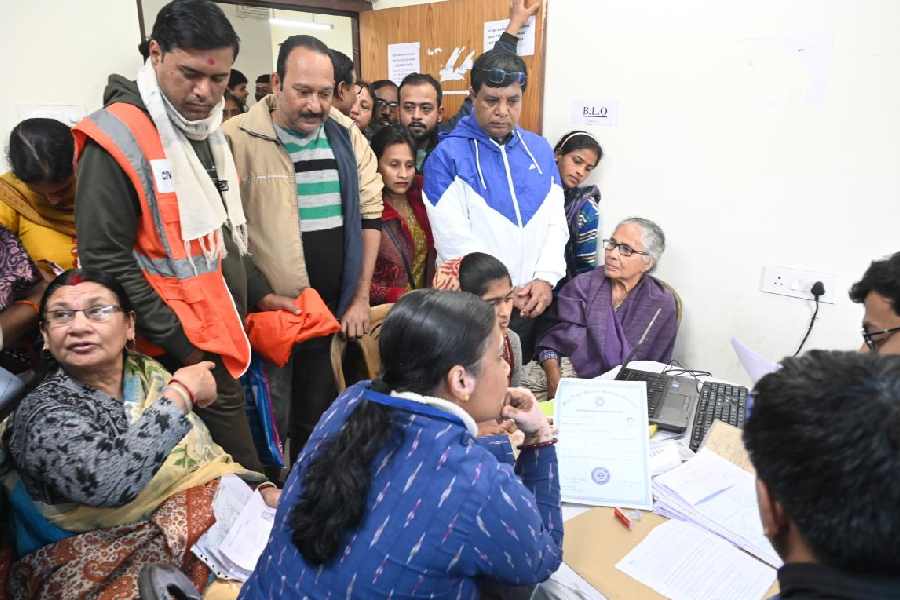 |
| The exotic steamed Alaskan king crab with egg custard is a favourite at House of Ming at The Taj Mahal Hotel Delhi |
Do you think asparagus risotto and strawberry-balsamic ice cream is a rather oddball combination? Would you dare to bite into sushi and sashimi made with grilled fugu — that potentially lethal blowfish which can kill you within 24 hours of eating if not impeccably prepared?
As for the blowfish, just relax — the chefs at San-Qi at Four Seasons Hotel Mumbai taste each fish that they prepare before serving it. But as top chefs don their creative caps to put innovative dishes on their menus, Indians are on a gastronomic journey that’s full of spectacular surprises.
 |
| White asparagus risotto with black truffles is a super-expensive dish created by chef Sandeep Kalra at Trident Gurgaon Pic by Rupinder Sharma |
Modern chefs have taken different routes to get creative as they battle for diners in India’s ever more fiercely competitive culinary world. Some are sticking to authentic ingredients but preparing them with new techniques. Others are trying out unlikely combinations of flavours and ingredients. And then there are those who are pulling out all the stops and going with unusual and exotic ingredients while making their plate presentations super-aesthetic.
“Cuisines evolve and chefs must stay ahead of the increasingly sophisticated palates of their guests,” says chef Willi Haueter, executive chef, The Imperial New Delhi.
 |
| San-Qi at Four Seasons Hotel Mumbai is the only restaurant in India that serves sushi and sashimi made using the deadly Japanese blowfish, fugu |
 |
| Chef Sabyasachi Gorai’s organic honey glazed black cod is a huge hit at Olive Pic by Rupinder Sharma |
Haueter, for one, is certainly making sure he stays ahead of the curve and serves up plenty of surprises for his guests. Take his miso-glazed Rocky Mountain oysters. The name of the dish is a bit of a misnomer actually because the prime ingredient is carefully prepared and peeled lamb testicles.
Though he’s Swiss, Haueter finds inspiration in Japanese cuisine. So, his menus include a large number of exotic offerings that are a fusion of Mediterranean and Japanese recipes and ingredients. For instance, soya sauce combines with butter and cream, while wasabi and mayonnaise come together in his French sauces. To stir the pot even more, Japanese marinades go into meats that are finished in a Mediterranean way.
Drive over to the Trident Gurgaon and you’ll still find innovative cooking, but with a more traditional touch. Executive chef Sandeep Kalra says of his brand of innovation: “All the dishes are very modern but carry a traditional heart.” His Oriental favourite includes miso marinated Scottish salmon with hajikame (pickle ginger shoot to you and me) and Balsamic teriyaki sauce, which is an unusual marriage of Japanese and Western cuisines.
INGREDIENTS ARE KING
The chefs are constantly on the lookout for cutting-edge flavours and new ingredients. Sometimes they bank on exotic and expensive fare — like the potentially deadly delicacy, fugu, or white asparagus — while others favour more humble stuff like sea salt and flavoured oils.
 |
 |
| At Afraa, chef Chiranjib Chatterjee’s Kolkata bekti comes with an unusual burnt green mango, pickled ginger and green chilli dressing |
Chef Sabyasachi Gorai — chef Saby to most — who is culinary director, Olive, believes in simple cooking methods using the finest quality ingredients that are not just exotic but also nourishing. He’s all for ingredients like home-made mustard and organic honey. A signature dish at Olive in Delhi is black cod that’s been glazed with organic honey.
“The simplest ingredients can have powerful flavours,” agrees chef Chiranjib Chatterjee of Afraa, in Calcutta. He uses fresh pomegranate juice as marinade and combines hot and sweet flavours like green chillis and mango in sorbets.
And sometimes — depending on the preparation or recipe — he uses oils to work up an intense flavour. “I love to prepare smoked hilsa salad with an innovative dressing using smoky mustard oil,” he says.
Some chefs including chef Joymalya Banerjee of Bohemian and chef Bakshish Dean, corporate chef, Lite Bite Foods (LBF), have gone ‘glocal’ — they are rooting for locally available ingredients. At Bohemian — a restaurant that’s synonymous with contemporary Bengali cuisine — recipes are based on easily sourced Bengali ingredients.
Meanwhile at Zambar, a South Indian speciality chain, and Asia 7, both promoted by Lite Bite Foods (LBF), Dean likes to keep to original recipes. So, he uses ingredients from specific regions to keep the dishes authentic. That means, for instance, he will source his tamarind from Chennai that is different in tartness and thickness from tamarind from Andhra.
 |
 |
| Chef Bakshish Dean likes to give traditional dishes a modern touch |
But on the other hand, at pan Asian restaurant, Asia 7, Dean is likely to be waving his creative wand to conjure up exotic ingredients like Goji berry, exotic yellow fungus, dried scallops and even herbal Chinese medicines that he uses in dishes.
Some of the chefs have a huge check-list of exotic ingredients that they want at their disposal. That might include single origin chocolates used to create chocolate pralines or akagai (red shell fish) used in sashimi and fresh sisho leaves for sushi rolls and maple syrup from Canada.
Manish Sharma of The Oberoi Gurgaon, for instance, likes to have at the ready Peruvian asparagus, morel mushrooms and Kerala kokum, which imparts a smoky flavour to the dish.
A stone’s throw away at the Trident Gurgaon, Kalra is getting creative with the rare white asparagus in a risotto combined with black truffles. He’s also quite partial to hajikame used with Japanese marinated salmon and Thai pomelo — a grapefruit-esque fruit — that he’s using as a summer salad ingredient.
A MODERN EDGE
Now with so much at their disposal, the chefs have a real chance to be extra-inventive. Their cooking methods are sophisticated and they are plating some new-style dishes that range from a fusion of cuisines to unexpected combinations of flavours and ingredients. How about a little bit of blue cheese stuffed kulcha or olive oil ice-cream, for instance?
But sometimes, not everything plays out as anticipated and chefs have to invent on the fly. When chef Mickey Bhoite, chef de cuisine at Le Cirque, the gourmet French restaurant at The Leela Palace New Delhi found that the taste of Italian mozzarella differed totally from the in-house mozzarella, he decided it couldn’t be helped and made something completely new. He imparted a fluffy texture to the cheese in his signature dish, the double-cooked mozzarella ‘caprese’. In his take on the classic caprese, the mozzarella is cooked a second time in cream. Then it is infused with basil for a pudding-like texture that “looks good and feels gourmet,” says Bhoite.
 |
 |
| Chef Mickey Bhoite recommends Le Cirque’s double-cooked mozzarella caprese, which is his signature dish |
The freshness of the ingredients — especially seafood — is crucial to make food taste best, say the chefs. At The Oberoi Gurgaon’s all-day dining threesixtyone degrees, Japanese chef Hiroshi has acquired a fan following with his speciality sashimi and sushi made with karuma ebi or Japanese imperial prawn and yari ika — spear head squid.
Meanwhile crab is a winner at The Taj Mahal Hotel Delhi’s Chinese restaurant House of Ming. The presentation of the steamed Alaskan king crab with egg custard and deep fried juicy shrimp dumplings also makes for a visual treat.
No wonder then that chef Sharad Dewan, director, food production, at The Park in Calcutta, says: “Food has to be dynamic — that’s what keeps people coming back.” He’s gone aggressively contemporary too and for the main course has conjured up Dahi Bhaat Aranchini or Italian style rice balls made with south Indian curd rice. His risottos — which are a huge hit — are paired with flavoured ice-cream which works as a frozen sauce. There’s his Ilish risotto with raw mango ice-cream and pumpkin risotto with achaar oil ice cream. He has also created an aromatic and flavourful ilish or Hilsa sushi.
Unusual combinations come together at Zambar in Delhi where you are served rasam and buttermilk froth as you sit down to your meal. Modern touches are given to the traditional Kochi lamb chops that are served with dal pancake. And for dessert there’s always coconut and jaggery pudding with Kerala vanilla.
 |
| At Bohemian, chef Joymala Banerjee has experimented with different flavours in his Daab Chingri Dynamite |
SIMPLY CREATIVE
But at another level, the chefs are turning out winning dishes with everyday ingredients. At Afraa, try the Kolkata bekti with burnt green mango, pickled ginger, and green chili dressing that was inspired by the humble aam porar shorbot. “That’s nothing but seasoned burnt mango puree. I just added some finely chopped green chilies for some extra sharpness,” says Chatterjee.
But even simple recipes and ingredients are being turned on their heads and presented differently. At Jamavar, the Indian fine dining restaurant at The Leela Palace, chef Vinod Saini has come up with a dish that he has dubbed Murgh ki Chaap. “It’s unusual because one is accustomed to mutton chops — not chicken chops!” he smiles.
 |
| Miso-glazed Rocky Mountain oysters on tea noodles is chef Willi Haueter’s signature dish at The Imperial New Delhi |
Don’t think for a moment that vegetarians are being neglected in this storm of culinary inventiveness. For even the humble paneer is being given a makeover by many chefs. Kalra at Trident Gurgaon offers an unusual preparation, Tandoori Paneer Latika, which is an Indian cottage cheese roulade or roll filled with dry fruits, basted in a light yoghurt marinade, skewered and cooked in tandoor.
It’s clear that India’s super chefs have switched to extreme creative mode, devising out-of-the-box recipes that highlight their individual talents and tastes. “If you have the imagination, then the possibilities to create new dishes — even with the most ordinary ingredients — are endless,” says Sharma of The Oberoi in Gurgaon.
 |
 |
| Chef Bakshish Dean likes to give traditional dishes a modern touch |
Coconut jaggery pudding (serves 6-8)
Ingredients
• 1lt cooking cream • 400ml coconut milk • 250ml + 250ml jaggery syrup • a pinch of nutmeg • a pinch of cinnamon powder • 6 egg whites + 4 whole eggs
Method
Mix the cooking cream, coconut milk, 250ml jaggery syrup, nutmeg and cinnamon. Whisk the eggs and the whites and fold into the mixture. Pour this into serving bowls and steam cook for 20-25 minutes. Serve with a shot of jaggery syrup and vanilla stick.










